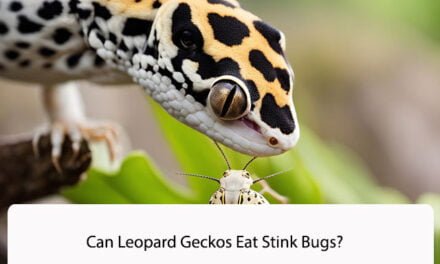Leopard geckos are fascinating creatures that make great pets for reptile enthusiasts. As with any pet, it’s important to understand their behavior and dietary needs to ensure they stay healthy and happy. One question that often arises among leopard gecko owners is whether or not these creatures can eat each other.

The short answer is yes, leopard geckos can eat each other. However, this behavior is not common in captivity and usually only occurs in specific circumstances. In the wild, leopard geckos may eat each other as a way to survive when food is scarce. But in captivity, this behavior is usually a result of overcrowding or inadequate food sources. It’s important to understand the reasons behind this behavior and take steps to prevent it from happening in your own leopard gecko enclosure.
Leopard Gecko Cannibalism

Leopard geckos are known for their docile nature and make great pets. However, under certain circumstances, leopard geckos can exhibit cannibalistic behavior towards each other. In this section, we will discuss the causes of cannibalism and the prevalence of this behavior among leopard geckos.
Causes of Cannibalism
Cannibalism among leopard geckos can be caused by a variety of factors. One of the main causes is overcrowding. When leopard geckos are kept in small enclosures with limited space, they may become territorial and aggressive towards each other. This can lead to cannibalistic behavior, as one gecko may view the other as a threat to its territory.
Another cause of cannibalism is hunger. Leopard geckos are carnivorous and require a diet of live insects. If they are not fed enough or if their food source is limited, they may turn to cannibalism as a means of survival.
Prevalence Among Leopard Geckos
Cannibalism is not a common behavior among leopard geckos in the wild. However, in captivity, it can occur more frequently due to the conditions in which they are kept. It is important to provide leopard geckos with adequate space, food, and hiding places to prevent cannibalistic behavior.
In conclusion, leopard gecko cannibalism can be caused by overcrowding and hunger, and is more prevalent in captivity than in the wild. By providing leopard geckos with proper care and a suitable environment, we can help prevent this behavior from occurring.
Dietary Needs of Leopard Geckos

Leopard geckos are insectivores, which means they require a diet that is high in protein and low in fat. In order to maintain their health, it is important to provide them with a balanced diet that meets their nutritional requirements and includes safe foods.
Nutritional Requirements
Leopard geckos require a diet that is high in protein, low in fat, and contains essential vitamins and minerals. A balanced diet for a leopard gecko should consist of 60-70% insects, 20-30% vegetables, and 10% fruit. It is important to vary their diet to ensure they receive all the necessary nutrients.
Leopard geckos require a high level of calcium in their diet to maintain healthy bones and prevent metabolic bone disease. They also require vitamin D3 to absorb calcium from their food. Dusting their food with calcium and vitamin D3 supplements is a great way to ensure they receive these essential nutrients.
Safe Foods
Leopard geckos can eat a variety of insects, including crickets, mealworms, waxworms, and roaches. It is important to avoid feeding them insects that are too large, as they can cause impaction. Insects should be gut-loaded with nutritious food before feeding them to your gecko.
Leopard geckos can also eat a variety of vegetables, including carrots, squash, and leafy greens. Fruits such as mango, papaya, and figs can also be fed in moderation. It is important to avoid feeding them foods that are high in fat or sugar, as this can lead to obesity and health problems.
In conclusion, providing a balanced diet that meets the nutritional requirements of leopard geckos is essential for their health and well-being. By offering a variety of safe foods and supplementing their diet with calcium and vitamin D3, we can ensure they receive all the necessary nutrients to thrive.
Housing and Environment

Territorial Behavior
Leopard geckos are known to be solitary animals and can become territorial with other geckos. This territorial behavior can lead to aggression and even cannibalism. It is important to house leopard geckos separately to prevent any potential harm to one another. Even if two geckos seem to get along well, it is not recommended to house them together as their behavior can change suddenly.
Optimal Terrarium Setup
To ensure the best possible living conditions for your leopard gecko, it is important to provide an optimal terrarium setup. The terrarium should be at least 20 gallons in size, with a secure lid to prevent escape. The substrate should be a non-toxic, non-ingestible material such as reptile carpet or paper towels. The temperature should be maintained between 85-90°F on the warm side and 75-80°F on the cool side. A heat source such as an under-tank heater or ceramic heat emitter can be used to maintain the temperature. A hide box should also be provided for the gecko to retreat to when feeling stressed or threatened.
In summary, housing leopard geckos together can lead to territorial behavior and even cannibalism. It is important to provide each gecko with their own optimal terrarium setup to ensure their safety and well-being.
Preventing Aggression
Leopard geckos are known to be solitary creatures, and keeping them in the same tank can lead to aggression and even cannibalism. Here are some techniques to prevent aggression among leopard geckos.
Proper Feeding Practices
One of the main reasons why leopard geckos become aggressive towards each other is due to competition for food. To prevent this, it is important to feed them separately and ensure that each gecko gets enough food. Overfeeding can also lead to aggression, as leopard geckos can become territorial over their food.
Separation and Isolation Techniques
If you notice any signs of aggression among your leopard geckos, it is important to separate them immediately. You can do this by creating separate enclosures for each gecko. This will not only prevent aggression, but it will also ensure that each gecko gets enough space and resources to thrive.
Isolation techniques can also be used to prevent aggression. If you have a sick or injured leopard gecko, it is important to isolate them from the rest of the group to prevent any further harm. This can be done by creating a separate enclosure or by using a divider to separate the sick or injured gecko from the others.
By following these proper feeding practices and separation techniques, you can prevent aggression among leopard geckos and ensure that they live happy and healthy lives.
Health Implications
When it comes to leopard geckos eating each other, there are several health implications that need to be considered. In this section, we will discuss the physical injuries that can occur as well as the stress and health issues that can arise.
Physical Injuries
Leopard geckos are known to be cannibalistic, and this can lead to serious physical injuries. When a leopard gecko attacks and eats another leopard gecko, it can cause wounds and lacerations that can become infected. In addition, the gecko that is being attacked may try to defend itself, leading to injuries on both sides.
If the injuries are severe enough, they can lead to death. Even if the gecko survives the attack, it may be left with permanent scars or disabilities that can affect its quality of life.
Stress and Health Issues
In addition to physical injuries, leopard geckos that are kept in close quarters with other geckos may experience stress and health issues. When geckos are housed together, they may compete for resources such as food, water, and shelter. This can lead to stress and anxiety, which can weaken their immune systems and make them more susceptible to illness.
Leopard geckos that are stressed may also exhibit abnormal behaviors such as loss of appetite, lethargy, and aggression. These behaviors can be a sign that the gecko is not thriving in its environment and may need to be housed separately.
In conclusion, while leopard geckos are fascinating creatures, it is important to understand the potential health implications of keeping them together. Physical injuries and stress can have serious consequences for these animals, and it is our responsibility as caretakers to provide them with a safe and healthy environment.
Breeding Considerations
Breeding leopard geckos is a rewarding and exciting experience. However, it is important to consider several factors before attempting to breed them. In this section, we will discuss sexual dimorphism and breeding season behavior.
Sexual Dimorphism
Sexual dimorphism refers to the physical differences between male and female leopard geckos. Males are generally larger than females and have a wider head. They also have pre-anal pores, which are used to release pheromones during breeding season. Females, on the other hand, have smaller bodies and lack pre-anal pores.
It is important to correctly identify the sex of your leopard geckos before attempting to breed them. Attempting to breed two males or two females can result in aggression and even death.
Breeding Season Behavior
Leopard geckos are seasonal breeders, meaning they only breed during certain times of the year. Breeding season typically occurs between January and September, with the peak breeding season being between February and May.
During breeding season, male leopard geckos will become more active and vocal. They will also display courtship behavior, such as head bobbing and tail waving, to attract females. Female leopard geckos will display receptive behavior, such as allowing the male to mount them.
It is important to provide your leopard geckos with the proper conditions during breeding season, including appropriate temperature and lighting. It is also important to monitor their behavior closely to ensure that breeding is successful and does not result in injury or death.
In conclusion, breeding leopard geckos requires careful consideration of their sexual dimorphism and breeding season behavior. By providing the proper conditions and monitoring their behavior closely, successful breeding can be achieved.
Frequently Asked Questions
Is cannibalism a behavior observed in leopard geckos?
Yes, cannibalism is a behavior that has been observed in leopard geckos. This is more commonly seen in geckos that are housed together and are of different sizes. Smaller geckos may be seen as prey by larger geckos, and this can lead to cannibalistic behavior.
What are the risks of housing multiple leopard geckos together?
Housing multiple leopard geckos together can increase the risk of fighting, stress, and injury. It can also lead to the spread of disease and parasites. If you choose to house multiple geckos together, it’s important to provide adequate space, hides, and food to reduce the risk of aggression and competition.
Can leopard geckos show aggression towards each other?
Yes, leopard geckos can show aggression towards each other, especially if they are housed together or if they are competing for resources. Signs of aggression can include biting, tail wagging, and vocalizations. It’s important to monitor your geckos for signs of aggression and separate them if necessary.
How can I prevent my leopard geckos from fighting?
To prevent fighting, it’s important to provide each gecko with its own space and resources. This includes separate hides, food dishes, and water dishes. It’s also important to monitor your geckos for signs of aggression and separate them if necessary.
What should I do if one leopard gecko bites another?
If one leopard gecko bites another, it’s important to separate them immediately to prevent further injury. Clean any wounds with an antiseptic solution and monitor the geckos for signs of infection. If the bite is severe or if you notice any signs of infection, consult a veterinarian.
Are baby leopard geckos at risk of being eaten by adult geckos?
Yes, baby leopard geckos are at risk of being eaten by adult geckos, especially if they are housed together. It’s important to provide separate housing for baby geckos until they are large enough to defend themselves.





